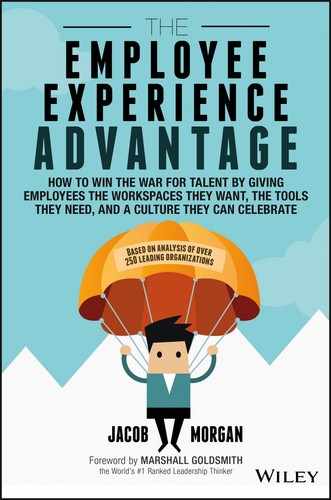CHAPTER 16
The Starbucks Model of Transparency
As you think about employee experiences, you might realize that the larger the organization becomes, the more ideas, feedback, and experiences you have to create. If your organization has 5,000 employees and half of them are contributing ideas or providing feedback regularly, that's still many thousands of ideas a year. What about an organization with 10,000 employees, 100,000 employees, or 300,000 employees? All of a sudden things can get a little bit out of control, and the employee experience design loop model starts to break down. Then what's the solution? How can an organization listen to the ideas of many thousands of people and then implement those ideas regularly? The answer is it can't. At least not yet. In the future as we start to see more AI in the workplace, organizations will be able to deliver an amazing amount of customized experiences. Software will “know” all employees, what they care about, what they value, what they want, and what they need individually. That type of granular view of employees is just not possible or practical today. You've heard of all sorts of smart things, such as the Nest Thermostat that knows when you're home, what temperature you like and when, what time you go to sleep, and what overall temperature conditions you prefer your home to be in. Well what if we took that concept and applied it to how you work? AI that knows how you work better than you do!
For many years Starbucks has been a prime example of customer engagement and innovation through something it launched called “My Starbucks Idea.” Search for it online and you'll see what I'm talking about. Through this site Starbucks allows all customers around the world to submit ideas for things they would like the company to do or invest in. Although it seems like Starbucks has since throttled back the focus on My Starbucks Idea, there have been hundreds of thousands of ideas submitted by customers. These idea categories range from store atmosphere to social responsibility to food and drink. The way that Starbucks manages all these ideas is through one magical concept, transparency. On the site, customers vote up which ideas they would like to see implemented, and Starbucks lets the community know which ideas are being evaluated, which ideas are being implemented, which ones have launched, and even which ideas haven't gone over well.
With this level of transparency customers are okay with the fact that not every idea or piece of feedback will be implemented because they know why. I like to call this the “Oh, okay” moment. It's when you get a bit wound up about something, and then once you understand the rationale for why something happened the way it did, you relax and say, “Oh, okay.”
Starbucks customers know what the company is doing, thinking about, and implementing. Although organizations always talk about transparency, imagine implementing this type of concept inside of your organization that is focused on employees. What would it be like if your people could provide feedback and ideas around culture, technology, and their physical work environment and see which ones are most popular, which the organization is actually thinking about implementing, and which ones haven't worked and why? I haven't seen any organization take it to this level yet. These types of things might happen more informally through discussions or conversations, but I believe implementing this type of concept (powered by technology, of course) would lead to some interesting results. Transparency is the best way to balance employee freedom with organizational control. It's a seesaw that sees transparency as the balance point in the middle. Not every organization is quite ready for this level of transparency, which is understandable. How much transparency should your organization allow for? As much as possible! The image below shows how transparency acts as the balance between employee freedom and organizational control.

In Work Rules! Laszlo Bock, the former senior vice president of people operations at Google, wrote, “If you believe people are good, you must be unafraid to share information with them.” At Google as much as possible is “default to open,” meaning “make as much information open and accessible as possible.” Almost all the entire Google code base, including Search, YouTube, AdWords, and AdSense, is accessible to a newly hired software engineer starting from day one. Its intranet portal, which has all the company road maps and plans along with employee quarterly goals, is also public for any other employee to see. Google also does weekly all‐hands meetings for many thousands of employees, and employees have the opportunity to ask literally any question they want to the most senior executives at the company. Nothing is off limits. Google does an excellent job of conveying not only what it is working on but also why it is working on certain things. Bock sums this up brilliantly:
Fundamentally, if you're an organization that says, “Our people are our greatest asset” (as most do), and you mean it, you must default to open. Otherwise, you're lying to your people and to yourself. You're saying people matter but treating them like they don't. Openness demonstrates to your employees that you believe they are trustworthy and have good judgement. And giving them more context about what is happening (and how and why) will enable them to do their jobs more effectively and contribute in ways a top‐down manager couldn't anticipate.1
